Presenting photographs I (and my guest contributors) have taken of our nation's institutions of higher education, along with their surrounding communities, this site is maintained by Dr. Alan Reifman of Texas Tech University. YOU CAN CLICK ON THE PHOTOS TO ENLARGE THEM.
Tuesday, November 14, 2006
Texas Tech University (Sothy Eng 2006)
One of our graduate students at Texas Tech, Sothy Eng, just took some fantastic photos of campus. Here's a link to the November 2006 archive of his photography blog, which contains the campus photos. Some of the photos are under the November 14 heading and others, under the November 13 heading. Some older photos I took of the Texas Tech campus are available here.
Wednesday, September 20, 2006
University of Texas-Austin -- January 2004
As is the case with many of my visits to college towns, my most recent trip to Austin took place in conjunction with an academic conference.
Like Madison, Wisconsin, featured in my entry immediately prior to this one, Austin hosts a huge, state university flagship campus, the state capitol building, and state historical society/museum. Pictured below is a collage of the famous Texas Tower from the UT campus, the Texas capitol building, and Texas State History Museum, all located in close proximity to each other.
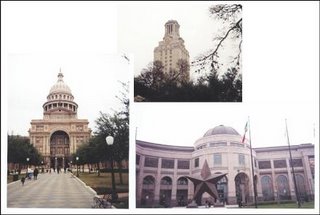
Downtown Austin and environs have a lot going on, all within walking distance (if you like a good walk). Austin is the self-proclaimed "Live Music Capital of the World" and home to the PBS music show Austin City Limits. Many visitors will want to go into some of the clubs on Sixth Street, but it's fun even to just walk up and down the blocks, which allows you to hear a new band's music coming out the front door every several seconds.
Another great thing about Austin is its relatively new airport, converted from the former Bergstrom Air Force Base. It's one of the most attractive airports I've ever seen, and has plentiful shopping venues, all, I'm told, based in local businesses.
[UPDATE: I visited UT-Austin again in 2009 and have some photos of that trip.]
Like Madison, Wisconsin, featured in my entry immediately prior to this one, Austin hosts a huge, state university flagship campus, the state capitol building, and state historical society/museum. Pictured below is a collage of the famous Texas Tower from the UT campus, the Texas capitol building, and Texas State History Museum, all located in close proximity to each other.

Downtown Austin and environs have a lot going on, all within walking distance (if you like a good walk). Austin is the self-proclaimed "Live Music Capital of the World" and home to the PBS music show Austin City Limits. Many visitors will want to go into some of the clubs on Sixth Street, but it's fun even to just walk up and down the blocks, which allows you to hear a new band's music coming out the front door every several seconds.
Another great thing about Austin is its relatively new airport, converted from the former Bergstrom Air Force Base. It's one of the most attractive airports I've ever seen, and has plentiful shopping venues, all, I'm told, based in local businesses.
[UPDATE: I visited UT-Austin again in 2009 and have some photos of that trip.]
Wednesday, August 09, 2006
University of Wisconsin-Madison -- July 2004
The University of Wisconsin-Madison, in my opinion, represents the best combination I've seen of aesthetics, blending of a university and town, and walkability. I visited "Mad-Town" twice in the late 1980s while I was in graduate school at the University of Michigan, and did not get back until 2004, when I attended an academic conference.
The central area of Madison is an isthmus, defined by the Wikipedia as "a narrow strip of land that is bordered on two sides by water and connects two larger land masses."
On one end of the isthmus is the Wisconsin State Capitol building and at the other, just blocks away, is the UW campus. Between the two is State Street, an automobile-free pedestrian mall. Here are some shots I took of the capitol and State Street.
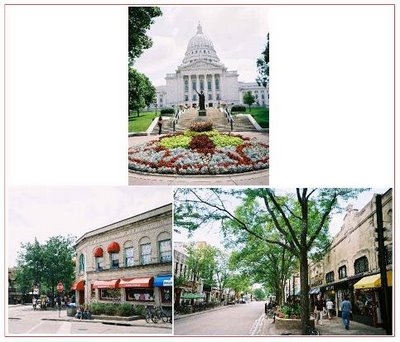
When entering the campus via State Street, one encounters a traditional-looking quad, as seen in the bottom photo of the following set...
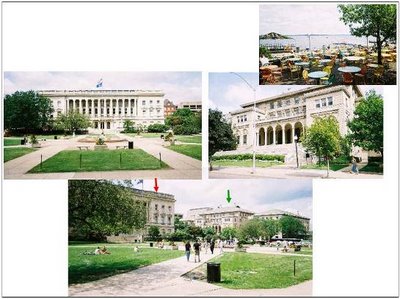
The little red arrow is pointing to the Wisconsin Historical Society, a straight-on view of which is shown directly above the arrow.
The little green arrow is pointing to the student union, a more direct shot of which is shown above that arrow. The back of the union faces Lake Mendota, one of the two bodies of water forming the isthmus. As can be seen, the union offers lakefront dining and entertainment (notice the stage).
The other body of water in the area is Lake Monona, where a lovely new conference center called Monona Terrace is located. One night at the conference, dinner was served in the glass-enclosed portion of the facility, then we had dessert up on the roof.
Note: I have added some new photos of the University of Wisconsin and the town of Madison from my recent (July-August 2007) visit, which are available here.
The central area of Madison is an isthmus, defined by the Wikipedia as "a narrow strip of land that is bordered on two sides by water and connects two larger land masses."
On one end of the isthmus is the Wisconsin State Capitol building and at the other, just blocks away, is the UW campus. Between the two is State Street, an automobile-free pedestrian mall. Here are some shots I took of the capitol and State Street.

When entering the campus via State Street, one encounters a traditional-looking quad, as seen in the bottom photo of the following set...

The little red arrow is pointing to the Wisconsin Historical Society, a straight-on view of which is shown directly above the arrow.
The little green arrow is pointing to the student union, a more direct shot of which is shown above that arrow. The back of the union faces Lake Mendota, one of the two bodies of water forming the isthmus. As can be seen, the union offers lakefront dining and entertainment (notice the stage).
The other body of water in the area is Lake Monona, where a lovely new conference center called Monona Terrace is located. One night at the conference, dinner was served in the glass-enclosed portion of the facility, then we had dessert up on the roof.
Note: I have added some new photos of the University of Wisconsin and the town of Madison from my recent (July-August 2007) visit, which are available here.
Monday, August 07, 2006
Northwestern University -- August 2002
With my sister and other relatives living in the Chicago area, I visit the Windy City on a roughly annual basis. One thing I always try to do is get to the Evanston campus of Northwestern University.
Northwestern is one of the most paradoxical universities in the nation, in my view. It is an academic powerhouse, ranked No. 12 for overall undergraduate education by U.S. News & World Report, for example.
Yet, I expect many would agree that the facilities are not up to what would be expected for such a great institution. Much of the campus is beautiful, modern, or both. But, as you'll see in a photo below, some departments and programs are located in old houses across the street from the core campus. Even on the main campus, some buildings are not state of the art. Part of the problem may have to do with space -- being on the lakeshore, there is a physical limitation of land. In fact, the Evanston history page linked above notes that, "In the 1960s Northwestern expanded its property by constructing a 74-acre landfill, altering the Lake Michigan shoreline." I've also been told that some buildings have been designated as historic sites, thus preventing their removal or renovation.
With my background introduction now out of the way, here are some shots of the Northwestern campus. What better place to start than this gate, the symbolic, if not literal, entrance to the campus?

The campus also contains what, to my untrained eye, looks to be Gothic architecture.
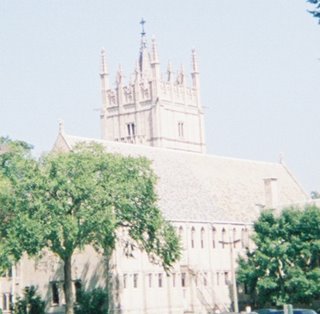
The Department of Statistics, shown next, is but one of a row of house-based academic units spanning along Sheridan Road (another being the Institute for Policy Research).
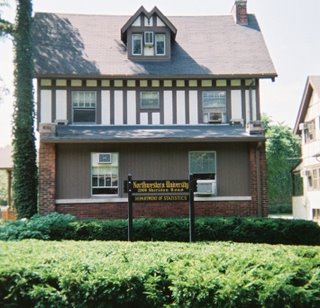
Finally, as can be seen throughout this blog, many of my campus visits have a sports tie-in. When the above photos were taken in August 2002, collegiate competition would have been on summer vacation. I've visited Northwestern a couple of times since then, however, and during my May 2006 trip, I took in some softball action, photos of which are shown on my softball blog. Northwestern ended up finishing second in the nation at the 2006 NCAA Women's College World Series.
Northwestern is one of the most paradoxical universities in the nation, in my view. It is an academic powerhouse, ranked No. 12 for overall undergraduate education by U.S. News & World Report, for example.
Yet, I expect many would agree that the facilities are not up to what would be expected for such a great institution. Much of the campus is beautiful, modern, or both. But, as you'll see in a photo below, some departments and programs are located in old houses across the street from the core campus. Even on the main campus, some buildings are not state of the art. Part of the problem may have to do with space -- being on the lakeshore, there is a physical limitation of land. In fact, the Evanston history page linked above notes that, "In the 1960s Northwestern expanded its property by constructing a 74-acre landfill, altering the Lake Michigan shoreline." I've also been told that some buildings have been designated as historic sites, thus preventing their removal or renovation.
With my background introduction now out of the way, here are some shots of the Northwestern campus. What better place to start than this gate, the symbolic, if not literal, entrance to the campus?

The campus also contains what, to my untrained eye, looks to be Gothic architecture.

The Department of Statistics, shown next, is but one of a row of house-based academic units spanning along Sheridan Road (another being the Institute for Policy Research).

Finally, as can be seen throughout this blog, many of my campus visits have a sports tie-in. When the above photos were taken in August 2002, collegiate competition would have been on summer vacation. I've visited Northwestern a couple of times since then, however, and during my May 2006 trip, I took in some softball action, photos of which are shown on my softball blog. Northwestern ended up finishing second in the nation at the 2006 NCAA Women's College World Series.
Thursday, August 03, 2006
Stanford University -- June 2003
As with my previous entry (below) on the University of Oregon, my trip to Stanford was in conjunction with a Track & Field News tour, to the 2003 USA national championships.
I've found when conversing with people about attractive college campuses that Stanford is frequently mentioned. The beige-brick style of the buildings, red-tile roofs (or is it "rooves"), and abundant use of arches give Stanford a very distinctive look, as shown in the following pictures (on which you can click to enlarge them).
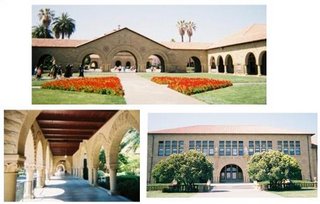
Don't get me wrong -- Stanford's is a nice-looking campus. However, I did not feel mesmerized by the aesthetics and ambience. While visiting with a couple of my former Michigan psychology professors who had moved to Stanford, we agreed that Stanford did not have the "buzz" of energy and excitement that Michigan has. In large part, this is because the UM campus blends seamlessly with the Ann Arbor community, whereas Stanford's size and clear demarcation of its perimeter left me feeling distant from its Palo Alto surroundings.
A better parallel may be between Stanford and Texas Tech, where I'm on the faculty. No less an authority than Red Raider basketball coach Bob Knight, whose son Tim went to Stanford, told a story on Larry King Live (transcript) about how they thought the Texas Tech campus looked similar to Stanford's. You can judge for yourself (albeit based on a small number of photos) by comparing the Stanford shots in this entry to pictures of Texas Tech I posted in an earlier one.
This entry wouldn't be complete without a photo from the track meet, so here's one of Texas Tech's Jonathan Johnson in the men's 800 meters (second from the right, wearing red).

I've found when conversing with people about attractive college campuses that Stanford is frequently mentioned. The beige-brick style of the buildings, red-tile roofs (or is it "rooves"), and abundant use of arches give Stanford a very distinctive look, as shown in the following pictures (on which you can click to enlarge them).

Don't get me wrong -- Stanford's is a nice-looking campus. However, I did not feel mesmerized by the aesthetics and ambience. While visiting with a couple of my former Michigan psychology professors who had moved to Stanford, we agreed that Stanford did not have the "buzz" of energy and excitement that Michigan has. In large part, this is because the UM campus blends seamlessly with the Ann Arbor community, whereas Stanford's size and clear demarcation of its perimeter left me feeling distant from its Palo Alto surroundings.
A better parallel may be between Stanford and Texas Tech, where I'm on the faculty. No less an authority than Red Raider basketball coach Bob Knight, whose son Tim went to Stanford, told a story on Larry King Live (transcript) about how they thought the Texas Tech campus looked similar to Stanford's. You can judge for yourself (albeit based on a small number of photos) by comparing the Stanford shots in this entry to pictures of Texas Tech I posted in an earlier one.
This entry wouldn't be complete without a photo from the track meet, so here's one of Texas Tech's Jonathan Johnson in the men's 800 meters (second from the right, wearing red).

Tuesday, August 01, 2006
University of Oregon -- June 2001
One of my favorite sports is track and field (for which, believe it or not, I don't have a blog). The magazine Track & Field News organizes tours to major meets, and I've gone on a few of them. One of the meets I went to with T&FN was the 2001 USA national championships, at the University of Oregon in Eugene. In fact, Eugene calls itself "Track Town USA," and there are establishments with names such as "Track Town Pizza." Here are some photos I took on that trip.
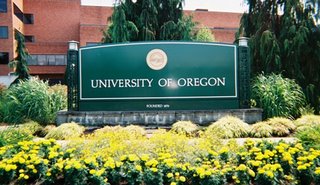
As is typical for the Northwest, UO's campus is very lush and green, with a mixture of old and new buildings (the photos below are kind of small, but you can click on them -- or any others -- to see a larger version).
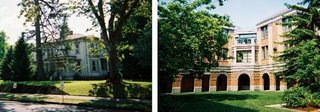
On the athletic side, here's a picture I took at the meet. Leigh Daniel, a former student of mine at Texas Tech, is shown on the far left of the pack in the women's 10,000 meters.

More recent information on Leigh is available here and here.
I also went by the legendary McArthur Court, also known as "The Pit," which is the home of Duck basketball. It was open, so I went in. The seating area takes the form of overhanging decks. The only problem (as shown below right) is that the decks hang so low, the view from the lower level is obstructed. I'm all for tradition, but in the case of Oregon basketball, it's probably time for a new arena!
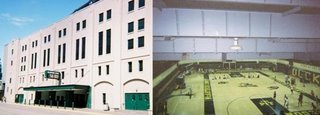

As is typical for the Northwest, UO's campus is very lush and green, with a mixture of old and new buildings (the photos below are kind of small, but you can click on them -- or any others -- to see a larger version).

On the athletic side, here's a picture I took at the meet. Leigh Daniel, a former student of mine at Texas Tech, is shown on the far left of the pack in the women's 10,000 meters.

More recent information on Leigh is available here and here.
I also went by the legendary McArthur Court, also known as "The Pit," which is the home of Duck basketball. It was open, so I went in. The seating area takes the form of overhanging decks. The only problem (as shown below right) is that the decks hang so low, the view from the lower level is obstructed. I'm all for tradition, but in the case of Oregon basketball, it's probably time for a new arena!

Thursday, July 27, 2006
The Ohio State University -- May 2005
The weekend of May 19-22, 2005, I visited The Ohio State University to attend the U.S. Conference on Teaching Statistics (USCOTS). While there, I also gave a talk to the Group for Attitudes and Persuasion on the Election '04 Study I organized, visited the Ohio Statehouse (state capitol), attended a Buckeyes' baseball game, and went into the Jack Nicklaus Museum (adjacent to the baseball stadium on campus). You might say I like to get the most out of my trips!
I took a lot of pictures at Ohio State. In order to have this website load relatively quickly, however, I try to hold it down to three or four pictures per entry. What I did here, therefore, is edit sets of pictures into collages in PowerPoint, then save each collage as a singular photo. You can click directly on the photos below to make them bigger.
One lovely area of the campus includes Lazenby Hall, home of the social psychology program, and Mirror Lake. There's also a campus historical marker, which can be seen in the lake photos on the left-hand side.

The OSU campus was just teeming with what appeared to be new buildings, a sign of the university's vitality. The building on the left, below, is the new Physics Research Building, which I took note of because of my layperson interest in physics.
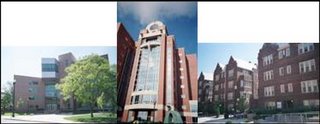
No trip to Ohio State would be complete without the famous "Horseshoe," also known as Ohio Stadium (and I say this as someone who's grown critical of the violence and injuries in football over the years). Also, back in the spring of 1984, when I visited OSU to look at it for graduate school (I ultimately chose Michigan instead), the OSU social psychology program was located under the stands in an office component of the football stadium.

I had posted a set of OSU photos in a different location previously, which was discovered by someone named David Burns. He e-mailed me some web links with historical information on Ohio Stadium and its design (well worth a look).
I also like to show a little bit of the area surrounding a given campus, which ideally will mean plenty of pizza places and bookstores! As some of my Texas Tech colleagues who previously spent time at Ohio State had told me before my trip, the campus is ringed by a number of local establishments and very few national franchises. Among those I visited are captured in another collage I made...

Flying Pizza and Long's Bookstore (as of the time I photographed it) are both on High Street, on the eastern border of the campus. The Varsity Club is on Lane Avenue, on the northern border, by the athletic facilities. As of my visit, Long's was slated to be moving south a few blocks, part of being blended into a huge new Barnes and Noble's.
Finally, here's a shot of the state capitol building in downtown Columbus; it can be reached easily by a bus that goes down High Street.
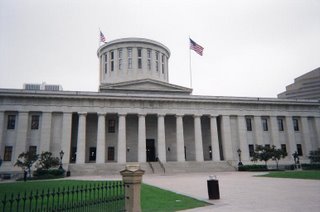
I took a lot of pictures at Ohio State. In order to have this website load relatively quickly, however, I try to hold it down to three or four pictures per entry. What I did here, therefore, is edit sets of pictures into collages in PowerPoint, then save each collage as a singular photo. You can click directly on the photos below to make them bigger.
One lovely area of the campus includes Lazenby Hall, home of the social psychology program, and Mirror Lake. There's also a campus historical marker, which can be seen in the lake photos on the left-hand side.

The OSU campus was just teeming with what appeared to be new buildings, a sign of the university's vitality. The building on the left, below, is the new Physics Research Building, which I took note of because of my layperson interest in physics.

No trip to Ohio State would be complete without the famous "Horseshoe," also known as Ohio Stadium (and I say this as someone who's grown critical of the violence and injuries in football over the years). Also, back in the spring of 1984, when I visited OSU to look at it for graduate school (I ultimately chose Michigan instead), the OSU social psychology program was located under the stands in an office component of the football stadium.

I had posted a set of OSU photos in a different location previously, which was discovered by someone named David Burns. He e-mailed me some web links with historical information on Ohio Stadium and its design (well worth a look).
I also like to show a little bit of the area surrounding a given campus, which ideally will mean plenty of pizza places and bookstores! As some of my Texas Tech colleagues who previously spent time at Ohio State had told me before my trip, the campus is ringed by a number of local establishments and very few national franchises. Among those I visited are captured in another collage I made...

Flying Pizza and Long's Bookstore (as of the time I photographed it) are both on High Street, on the eastern border of the campus. The Varsity Club is on Lane Avenue, on the northern border, by the athletic facilities. As of my visit, Long's was slated to be moving south a few blocks, part of being blended into a huge new Barnes and Noble's.
Finally, here's a shot of the state capitol building in downtown Columbus; it can be reached easily by a bus that goes down High Street.

Wednesday, July 19, 2006
Indiana University Bloomington -- May 2006
Two months ago, I attended a conference on networks at IU Bloomington. I had visited previously in the spring of 1984 to consider Indiana for graduate school, but after 22 years, I really didn't remember much about the campus or town, other than that I had had a favorable impression of both.
On my return visit in 2006, the campus and town didn't disappoint (by "town," I refer to the restaurants, shops, etc., catering to the college community and not the residential parts). In fact, the campus and town were contiguous, which is not always the case around the country.
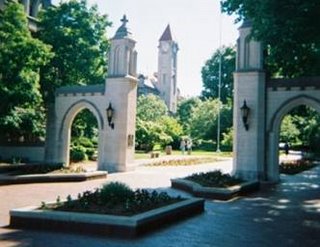
Coming up Kirkwood St., which seemed to be the "main drag," one enters campus at the Sample Gates (at some point IUB will presumably put in real gates, just kidding).
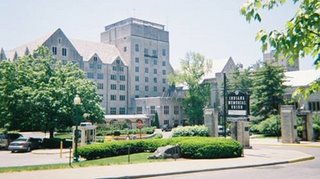
Just about anywhere, the student union plays a major role, although on some campuses more than others. Here in Hoosier land, the Indiana Memorial Union plays a huge role, as it is said to be one of the largest student unions in the world.
Another thing about the IUB campus that is lovely, but which initially made it hard for me to find my bearings, is that large amounts of space are devoted to natural beauty (e.g., trees, grass fields, streams), befitting of a national or state park. One example is shown below...

The campus seems to alternate between clusters of academic buildings and these open spaces; thus, when as a newcomer you find yourself in the middle of the nature areas, it can be hard to get oriented again as to where the buildings are. Also, other than on one side (by the hotel component), the huge Indiana Memorial Union complex has no signage. I spent a half hour trying to find the IMU on the first day of the conference, only to learn that I had walked by it several times unknowingly.
On the whole, though, Bloomington is a neat town, and IUB, a great campus.
On my return visit in 2006, the campus and town didn't disappoint (by "town," I refer to the restaurants, shops, etc., catering to the college community and not the residential parts). In fact, the campus and town were contiguous, which is not always the case around the country.

Coming up Kirkwood St., which seemed to be the "main drag," one enters campus at the Sample Gates (at some point IUB will presumably put in real gates, just kidding).

Just about anywhere, the student union plays a major role, although on some campuses more than others. Here in Hoosier land, the Indiana Memorial Union plays a huge role, as it is said to be one of the largest student unions in the world.
Another thing about the IUB campus that is lovely, but which initially made it hard for me to find my bearings, is that large amounts of space are devoted to natural beauty (e.g., trees, grass fields, streams), befitting of a national or state park. One example is shown below...

The campus seems to alternate between clusters of academic buildings and these open spaces; thus, when as a newcomer you find yourself in the middle of the nature areas, it can be hard to get oriented again as to where the buildings are. Also, other than on one side (by the hotel component), the huge Indiana Memorial Union complex has no signage. I spent a half hour trying to find the IMU on the first day of the conference, only to learn that I had walked by it several times unknowingly.
On the whole, though, Bloomington is a neat town, and IUB, a great campus.
Tuesday, July 18, 2006
University of Southern California -- Guest Photographer
After I posted a notice about my Texas Tech photo display on the RaiderPower.com chat site (the school's sports teams are known as the Red Raiders), someone who goes by the moniker "Raider Aficionado" commented about being at the University of Southern California recently and posted some pictures he or she had taken of the USC campus (the University of South Carolina also, of course, goes by USC). Raider Aficionado also kindly stated that I could use the photos for this blog, and so I'm posting some of them (as can be seen in all of my earlier postings, I'm generally limiting the number of photos per campus to three or four, so that the page will come up relatively quickly on most computers).
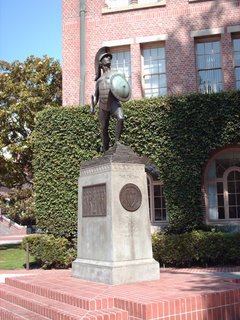
The central icon of the Southern Cal campus, of course, is the statue of Tommy Trojan, the school's athletic mascot. As documented here, Tommy needs to be protected from possible mischief by supporters of cross-town rival UCLA in the days leading up to the schools' annual football showdown.

Next is a shot of the Student Activities Center, which I believe Raider Aficionado took to illustrate the abundant trees on campus as much as the center.
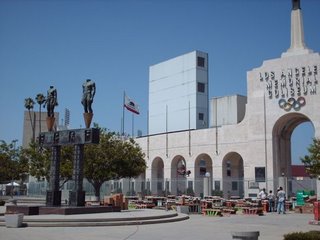
Finally, we have the L.A. Memorial Coliseum, located within walking distance of USC. In addition to being the home of the Trojan football team, the Coliseum has hosted two Olympics (1932 and 1984) and used to host L.A. Rams (now in St. Louis), L.A. Raiders (now back in Oakland), and UCLA Bruins (now at the Rose Bowl) football games. Also in the athletic realm, after many years of playing at the decaying L.A. Sports Arena near campus, the Trojan basketball teams will inaugurate a new on-campus facility, the Galen Center, this season.

The central icon of the Southern Cal campus, of course, is the statue of Tommy Trojan, the school's athletic mascot. As documented here, Tommy needs to be protected from possible mischief by supporters of cross-town rival UCLA in the days leading up to the schools' annual football showdown.

Next is a shot of the Student Activities Center, which I believe Raider Aficionado took to illustrate the abundant trees on campus as much as the center.

Finally, we have the L.A. Memorial Coliseum, located within walking distance of USC. In addition to being the home of the Trojan football team, the Coliseum has hosted two Olympics (1932 and 1984) and used to host L.A. Rams (now in St. Louis), L.A. Raiders (now back in Oakland), and UCLA Bruins (now at the Rose Bowl) football games. Also in the athletic realm, after many years of playing at the decaying L.A. Sports Arena near campus, the Trojan basketball teams will inaugurate a new on-campus facility, the Galen Center, this season.
Friday, July 14, 2006
Texas Tech University -- Assorted Photos
I've now displayed photos of UCLA and the University of Michigan, my undergraduate and graduate alma maters, respectively, in earlier postings. Now it's time for me to post some photos I took of Texas Tech University in Lubbock, where I've been a faculty member for nine years.
Texas Tech is very big on traditions, which comes across in some of these photos.
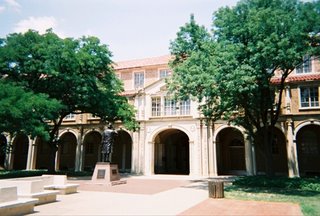
The shot above is of the Administration Building, viewed from the south. In the extreme lower left of the photo, all that can be made out is some type of white structure. What this can be seen to be, if one walks away from the building and toward the structure, is a bench in the shape of the school's famous Double-T logo. In between the bench and the building (facing the building) is a statue of former Texas governor Preston Smith, during whose tenure Texas Tech was upgraded from a college to a university.
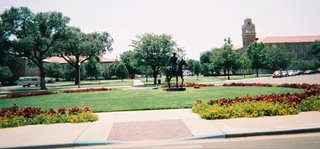

Here are two shots of the Will Rogers statue with his horse Soapsuds (Will Rogers's connection to Texas Tech is described in the "traditions" link above). The statue is located in a pretty, circular garden plaza. In the wider shot (above), one of the towers of the Administration Building is visible in the background, whereas the picture below provides more of a close-up of the statue.
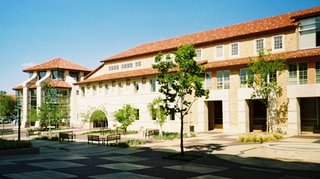
Finally, here's a shot of the new wing of the Student Union (only a few years old), as viewed from the side by the library. Prior to its major renovation project, I used to tell people that the Texas Tech Student Union was state of the art... circa 1940!
On the RaiderPower.com site, which is devoted to discussion of all things Texas Tech (heavily, though not exclusively, sports-related), someone who goes by the moniker "TTU Red" periodically posts links to pictures he or she has taken of the campus, which are a lot nicer than mine (what I hang my hat on is getting to a lot of campuses and taking pretty good pictures!). You can access Red's pictures by clicking here, then scrolling down a bit and clicking on "TTU Campus."
I consider Texas Tech to be one of the nicer campuses I've seen. However, its flatness, lack of more greenery, and absence of water -- I'm referring to streams, rivers, or lakes, not a lack of drinking fountains -- keep it from rising to my personal top tier of campuses.
Texas Tech is very big on traditions, which comes across in some of these photos.

The shot above is of the Administration Building, viewed from the south. In the extreme lower left of the photo, all that can be made out is some type of white structure. What this can be seen to be, if one walks away from the building and toward the structure, is a bench in the shape of the school's famous Double-T logo. In between the bench and the building (facing the building) is a statue of former Texas governor Preston Smith, during whose tenure Texas Tech was upgraded from a college to a university.


Here are two shots of the Will Rogers statue with his horse Soapsuds (Will Rogers's connection to Texas Tech is described in the "traditions" link above). The statue is located in a pretty, circular garden plaza. In the wider shot (above), one of the towers of the Administration Building is visible in the background, whereas the picture below provides more of a close-up of the statue.

Finally, here's a shot of the new wing of the Student Union (only a few years old), as viewed from the side by the library. Prior to its major renovation project, I used to tell people that the Texas Tech Student Union was state of the art... circa 1940!
On the RaiderPower.com site, which is devoted to discussion of all things Texas Tech (heavily, though not exclusively, sports-related), someone who goes by the moniker "TTU Red" periodically posts links to pictures he or she has taken of the campus, which are a lot nicer than mine (what I hang my hat on is getting to a lot of campuses and taking pretty good pictures!). You can access Red's pictures by clicking here, then scrolling down a bit and clicking on "TTU Campus."
I consider Texas Tech to be one of the nicer campuses I've seen. However, its flatness, lack of more greenery, and absence of water -- I'm referring to streams, rivers, or lakes, not a lack of drinking fountains -- keep it from rising to my personal top tier of campuses.
Thursday, July 13, 2006
University of Michigan -- Assorted Photos
As noted in the sub-heading at the top of this page, I went to graduate school at the University of Michigan in Ann Arbor, earning a Ph.D. in social psychology in 1989. So deeply do my feelings run for the maize and blue that I operate another blog devoted entirely to reminiscences on my UM years (and updates of what people from my era are doing now).
In the 17 years I've been away from Ann Arbor, I've generally managed to come back for visits every couple of years, give or take, and on my last few trips back, I've taken pictures of the campus and town. In recent months, I've posted some of these pictures on my Michigan retrospective site. Thus, the easiest thing for me to do is just provide links to my UM pictures on the other site.
If you click here, you'll see an entry that includes photos of some assorted UM campus landmarks. And if you click here and scroll down a bit, you'll see a picture of the Graduate Library, which faces the "Diag," a central gathering spot on campus through which two major walkways cross, you guessed it, diagonally.
Unlike many college campuses around the nation that have clearly defined perimeters, where there would be no mistaking if you were on or off campus, the University of Michigan campus has few, if any, sharp demarcations. Rather, campus buildings blend in with the town's businesses and residential sections.
As some of you may know, the UM-Ann Arbor campus actually consists of three non-contiguous tracts of land, the Central Campus, North Campus (containing among other things, the Schools of Engineering, Music, and Art, and a large graduate-student housing set-up), and South Campus (containing the athletic facilities).
When I refer to blending of campus buildings with the town, I do not mean the areas between the Central, North, and South Campuses. What I'm saying is that the Central Campus, itself, mixes seamlessly with commercial and private establishments.
In the 17 years I've been away from Ann Arbor, I've generally managed to come back for visits every couple of years, give or take, and on my last few trips back, I've taken pictures of the campus and town. In recent months, I've posted some of these pictures on my Michigan retrospective site. Thus, the easiest thing for me to do is just provide links to my UM pictures on the other site.
If you click here, you'll see an entry that includes photos of some assorted UM campus landmarks. And if you click here and scroll down a bit, you'll see a picture of the Graduate Library, which faces the "Diag," a central gathering spot on campus through which two major walkways cross, you guessed it, diagonally.
Unlike many college campuses around the nation that have clearly defined perimeters, where there would be no mistaking if you were on or off campus, the University of Michigan campus has few, if any, sharp demarcations. Rather, campus buildings blend in with the town's businesses and residential sections.
As some of you may know, the UM-Ann Arbor campus actually consists of three non-contiguous tracts of land, the Central Campus, North Campus (containing among other things, the Schools of Engineering, Music, and Art, and a large graduate-student housing set-up), and South Campus (containing the athletic facilities).
When I refer to blending of campus buildings with the town, I do not mean the areas between the Central, North, and South Campuses. What I'm saying is that the Central Campus, itself, mixes seamlessly with commercial and private establishments.
Monday, July 10, 2006
Welcome to the Site (Part II) -- Recent U. of Washington Photos
As part of the same West Coast trip that took me to Los Angeles and UCLA (see entry below), I also went to Seattle for the Society for American Baseball Research (SABR) conference. While there, I visited the University of Washington (known as "U-Dub" to locals) and took some photos.

As can be seen from the main entrance (above), the U-Dub campus is very verdant. The Husky Union Building or "HUB" (student union) is one of many buildings with a nice lawn adjacent to it (below).
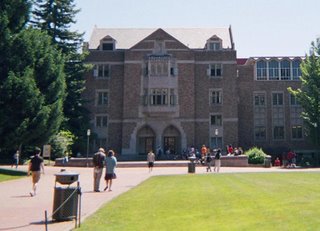
Here are a couple of other buildings around the HUB...
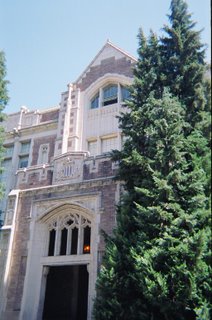

Finally, here's a shot of the University District, just west of campus on University Way (which is sometimes called University "Avenue"). The main bookstore for U-Dub students is here, rather than in the HUB, plus there are lots of restaurants and other amenities. Being in a big city sometimes detracts from the college-town feel of a community, but I think the U-District does a nice job of preserving that feel.


As can be seen from the main entrance (above), the U-Dub campus is very verdant. The Husky Union Building or "HUB" (student union) is one of many buildings with a nice lawn adjacent to it (below).

Here are a couple of other buildings around the HUB...


Finally, here's a shot of the University District, just west of campus on University Way (which is sometimes called University "Avenue"). The main bookstore for U-Dub students is here, rather than in the HUB, plus there are lots of restaurants and other amenities. Being in a big city sometimes detracts from the college-town feel of a community, but I think the U-District does a nice job of preserving that feel.

Thursday, July 06, 2006
Welcome to the Site (Part I) -- Recent UCLA Photos
I'm an academic, through and through. I've always enjoyed visiting college campuses and, more recently, photographing them. I've put various photo collections on the web over the years, but I've decided that I should have a central repository for my college campus photos. Hence, this blog. I recently was home visiting in Los Angeles. Therefore, to start things off, here are a few shots of my undergraduate alma mater, the University of California, Los Angeles (UCLA).
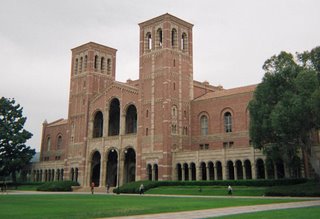
Pictured above is Royce Hall, one of the four original buildings on UCLA's Westwood campus. Royce's front exterior often serves as a symbol for UCLA as a whole.
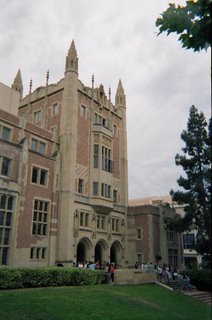
Next is Kerckhoff Hall, which adjoins the Ackerman Student Union and houses many offices of the type that would be found in a student union. I was a sportswriter for the Daily Bruin and our offices were in Kerckhoff. Nowadays, I would go to Kerckhoff primarily for its Coffee House, which also includes an ice cream component.

Immediately to the south of UCLA is Westwood Village. Up through, I would say, the 1970s (during my childhood and adolescence), Westwood had a bunch of quaint, traditional college-town business establishments. In more recent decades, however, things have gotten considerably more high-end (which also seems to be associated with a high turnover of businesses in some locations). In the photo above, which looks north along Westwood Blvd., you can see in the background a hint of the red-brick exterior to the UCLA Medical Center (which is slated to be replaced in about another year or so).
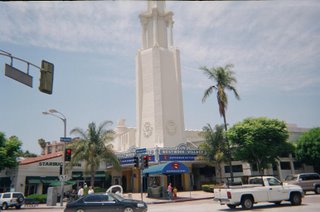
Finally, Westwood is one of the main movie-theater hubs in Los Angeles (along with Hollywood, of course), and while I was there, in fact, Westwood hosted the annual L.A. Film Festival. If they showed exclusively comedies, then the acronym LAFF would make sense, but they didn't. Pictured above is the Fox theater, a bit west of Westwood Blvd.

Pictured above is Royce Hall, one of the four original buildings on UCLA's Westwood campus. Royce's front exterior often serves as a symbol for UCLA as a whole.

Next is Kerckhoff Hall, which adjoins the Ackerman Student Union and houses many offices of the type that would be found in a student union. I was a sportswriter for the Daily Bruin and our offices were in Kerckhoff. Nowadays, I would go to Kerckhoff primarily for its Coffee House, which also includes an ice cream component.

Immediately to the south of UCLA is Westwood Village. Up through, I would say, the 1970s (during my childhood and adolescence), Westwood had a bunch of quaint, traditional college-town business establishments. In more recent decades, however, things have gotten considerably more high-end (which also seems to be associated with a high turnover of businesses in some locations). In the photo above, which looks north along Westwood Blvd., you can see in the background a hint of the red-brick exterior to the UCLA Medical Center (which is slated to be replaced in about another year or so).

Finally, Westwood is one of the main movie-theater hubs in Los Angeles (along with Hollywood, of course), and while I was there, in fact, Westwood hosted the annual L.A. Film Festival. If they showed exclusively comedies, then the acronym LAFF would make sense, but they didn't. Pictured above is the Fox theater, a bit west of Westwood Blvd.
Subscribe to:
Posts (Atom)